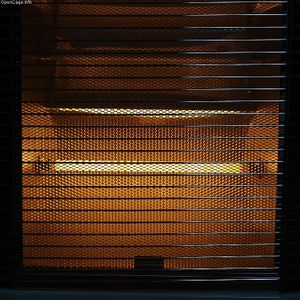Electric resistance heating is considered by some a very efficient form of energy conversion. In the process, electrical energy is taken and converted to heat. The efficiency of electrical-resistance heating can be very high. However, even with high efficiency, resistance heating tends to be more expensive than conventional combustion appliances such as natural gas and oil furnaces. This is due to the cost of electricity.
Most electricity is produced from coal, gas, or oil generators that convert only about 30% of the fuel's energy into electricity. Because of electricity generation and transmission losses, electric heat is often more expensive than heat produced in the home or business using combustion appliances, such as natural gas, propane, and oil furnaces.The heating area on most electric heaters generally looks like Fig. 1.

How it works
Resistors are materials with resistive properties to electric currents. As the current is run through an object the friction generated on the molecular level generates heat. In an electric furnace system, a current is run through a heating element, the resistance generates heat.
Generally, the air is circulated through a system and as it cycles through it is used to heat an area.[1]
Equations
The equation for resistance is:
Where R is the resistance in ohms, V is the voltage measured in volts, and I is the current in amps. The heat output can be measured by the equation
Where P is Power in watts, I is current in amps and is the voltage across the system.
Watts also equal to joules/second is the heat output per unit times.[2]
Appropriateness
Electric heaters use the electricity that is usually produced at power plants. These power plants often use the combustion of fossil fuels to produce electricity, sometimes at a rough efficiency of as low as 30%. Considering this low efficiency, taking fossil fuels, converting them into electricity, and then converting that electricity back to heat again may not be the best use of energy.[3]
References
- ↑ “Electric Resistance Heating” <http://energy.gov/energysaver/articles/electric-resistance-heating> U.S. Department of Energy.(June 24, 2012).
- ↑ "Resistive heating explained in details" EEP - Electrical Engineering Portal 7/07/11 <http://electrical-engineering-portal.com/resistive-heating-explained-in-details>
- ↑ "Saving Energy with Electric Resistance Heating" National Renewable Energy Laboratory. 10/01/97 <http://www.nrel.gov/docs/legosti/fy97/6987.pdf>

